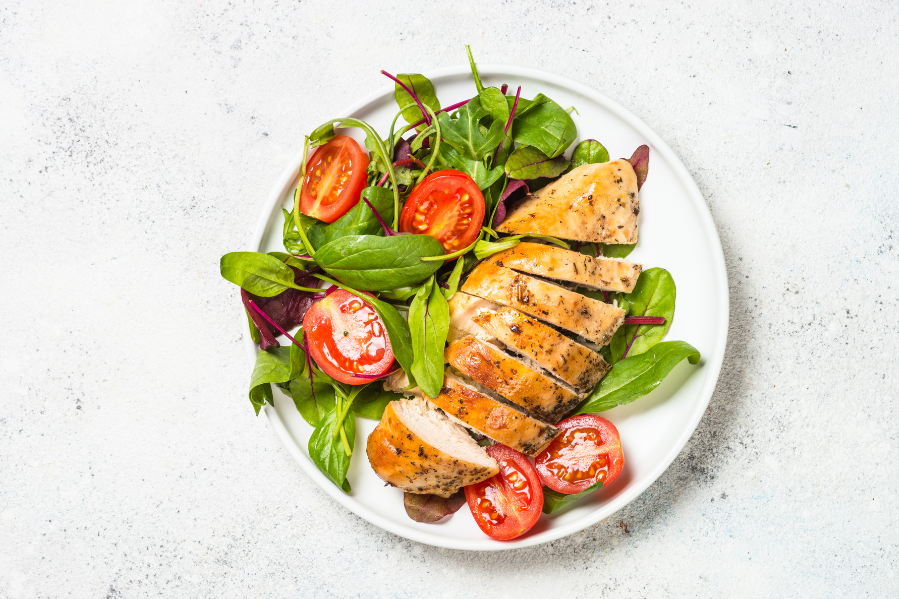The ketogenic diet is popular for its potential to promote rapid weight loss, attracting many with high expectations. However, some find themselves frustrated when the scale doesn’t move despite strict adherence to keto principles.
Several factors can contribute to this stall, including not achieving ketosis, hidden carbs, or consuming too many calories. To succeed on keto, careful monitoring and adjustment of macronutrients are essential, along with considering other factors like stress and sleep quality.
Understanding the Keto Diet
The ketogenic diet is a high-fat, low-carb eating plan designed to shift the body into a metabolic state called ketosis. It requires careful attention to macronutrient ratios and often involves misconceptions that can hinder weight loss progress.
Macronutrient Ratios
The standard ketogenic diet typically follows a strict macronutrient breakdown:
-
70-80% of calories from fat
-
15-20% from protein
-
5-10% from carbohydrates
This extreme reduction in carbs forces the body to use fat as its primary fuel source. Maintaining these ratios is crucial for entering and staying in ketosis.
Tracking macros accurately is essential. Many people underestimate their carb intake, which can prevent ketosis. Hidden carbs in foods like vegetables, dairy, and processed products can add up quickly.
Ketosis Explained
Ketosis occurs when the body lacks sufficient glucose for energy and begins breaking down stored fat. This process produces ketones, which serve as an alternative fuel source.
Entering ketosis usually takes 2-4 days of strict carb restriction. Signs of ketosis include:
-
Increased thirst
-
Frequent urination
-
“Keto breath” with a fruity odour
-
Decreased hunger
-
Increased energy and focus
Ketone levels can be measured through urine, blood, or breath tests to confirm ketosis.
Common Misconceptions
Many people mistakenly believe that simply cutting carbs is enough to lose weight on keto. However, calorie intake still matters. Consuming excess calories, even from healthy fats, can stall weight loss.
Another misconception is that protein can be eaten freely. Too much protein can be converted to glucose through gluconeogenesis, potentially kicking the body out of ketosis.
Some believe ketosis is dangerous. While it can cause initial side effects like the “keto flu,” it’s generally safe for most healthy individuals when done correctly. However, those with certain medical conditions should consult a doctor before starting.
Factors Affecting Weight Loss on Keto

Several key elements influence weight loss success on a ketogenic diet. These factors can impact ketosis, metabolism, and overall fat-burning efficiency.
1. Calorie Intake and Energy Expenditure
Calorie balance remains crucial, even on a keto diet. Consuming more calories than the body burns will hinder weight loss, regardless of macronutrient composition.
To lose weight, a calorie deficit is necessary. This means burning more calories than consumed. Many people overlook portion sizes of high-fat foods, which are calorie-dense.
Tracking food intake can help identify excess calorie consumption. Using a food diary or app to log meals and snacks provides valuable insights.
Physical activity also plays a role. Increasing exercise or daily movement boosts calorie expenditure, supporting weight loss efforts.
2. Hidden Carbs and Dietary Slip-Ups
Unintentional carb intake can disrupt ketosis and stall weight loss. Many foods contain hidden carbs that are easy to overlook.
Common sources of hidden carbs include:
-
Sauces and condiments
-
Processed meats
-
Some dairy products
-
Nuts and seeds
-
Certain vegetables
Reading labels carefully helps identify unexpected carb sources. Be wary of “net carbs” claims, as they can be misleading.
Occasional high-carb meals or snacks, even if infrequent, can knock the body out of ketosis. This metabolic shift can temporarily halt fat burning and weight loss progress.
3. Metabolic Adaptation
As weight loss occurs, the body’s metabolism may slow down to conserve energy. This natural adaptation can make further weight loss challenging.
Strategies to combat metabolic adaptation include:
-
Periodically adjusting calorie intake
-
Incorporating resistance training
-
Varying exercise intensity
-
Ensuring adequate protein consumption
Hormonal changes can also impact metabolism. Stress, lack of sleep, and certain medical conditions may affect weight loss, even when following a strict keto diet.
Regular health check-ups can help identify underlying issues that might be hindering progress. Addressing these factors may improve weight loss results on a ketogenic diet.
Potential Challenges and Solutions
The keto diet can present obstacles to weight loss. Addressing plateaus, electrolyte imbalances, and lifestyle factors like sleep and stress is crucial for overcoming these hurdles and achieving success.
1. Plateaus and How to Break Them
Weight loss plateaus are common on the keto diet. To overcome them, try adjusting calorie intake or macronutrient ratios. Incorporating intermittent fasting can jumpstart weight loss by promoting fat burning.
Adding high-intensity interval training (HIIT) to a workout routine can boost metabolism and break through stalls. Tracking food intake meticulously helps identify hidden carbs or excess calories that may be hindering progress.
Experimenting with cyclical keto or targeted keto approaches can also help. These variations introduce strategic carb intake to stimulate metabolism and support exercise performance.
2. Balancing Electrolytes
Electrolyte imbalances can impede weight loss on keto. The diet’s diuretic effect can lead to mineral depletion, causing fatigue and muscle cramps.
Increasing sodium intake through foods like bone broth or adding salt to meals can help. Potassium-rich keto-friendly foods include avocados, spinach, and salmon.
Magnesium supplements or foods like pumpkin seeds and almonds are beneficial. Staying hydrated is crucial, as water helps maintain electrolyte balance.
Monitoring symptoms and adjusting intake accordingly ensures optimal electrolyte levels. This balance supports energy levels and metabolic function, facilitating weight loss.
3. Importance of Sleep and Stress Management
Poor sleep and high stress levels can hinder weight loss on keto. Lack of sleep disrupts hormones that regulate hunger and metabolism, potentially leading to overeating.
Establishing a consistent sleep schedule and creating a relaxing bedtime routine can improve sleep quality. Limiting screen time before bed and ensuring a dark, cool sleeping environment are helpful strategies.
Chronic stress elevates cortisol levels, which can increase appetite and promote fat storage. Incorporating stress-reduction techniques like meditation, yoga, or deep breathing exercises can mitigate these effects.
Regular exercise, particularly low-intensity activities like walking or swimming, can reduce stress and improve sleep quality. Prioritizing self-care and setting realistic goals helps maintain a balanced approach to the keto lifestyle.
Evaluating and Adjusting Your Keto Diet
Tracking macronutrients is essential for success on a ketogenic diet. Many people unknowingly consume too many carbohydrates, preventing ketosis. Keeping carb intake under 20-50 grams per day is typically necessary.
Calorie intake also matters on keto. Even with low carbs, eating excess calories can stall weight loss. Using a food diary app can help monitor both macros and total calories consumed.
Protein intake requires balance on keto. Too little can lead to muscle loss, while excess may interfere with ketosis. Aim for moderate protein – about 0.6-1.0 grams per pound of body weight daily.
Increasing healthy fat intake can boost ketone production. Focus on sources like avocados, olive oil, nuts, and fatty fish. However, avoid overdoing fat calories if weight loss is the goal.
Intermittent fasting may help some people overcome weight loss plateaus on keto. Common methods include 16/8 fasting or occasional 24-hour fasts.
Stress and poor sleep can impact weight loss, even on keto. Prioritize stress management techniques and aim for 7-9 hours of quality sleep nightly.
Regular exercise complements a keto diet. Incorporate both cardio and strength training to support fat loss and preserve muscle mass.
Conclusion
Weight loss plateaus on a ketogenic diet can stem from hidden carbs, improper tracking, or lifestyle factors like stress and lack of sleep. To overcome stalls, reassess your macronutrients, consider intermittent fasting, increase physical activity, and stay consistent. If challenges persist, consulting a healthcare professional can provide tailored advice. Additionally, it’s important to note that while the keto diet helps in weight loss, individual responses to the diet can vary, and regular health monitoring is recommended.
Read Also: Cannoli Queen Amanda Labollita









